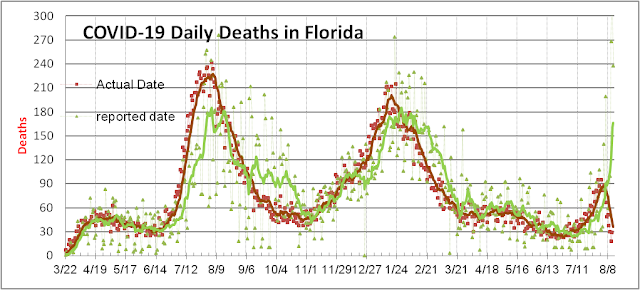COVID-19 Hospitalizations are Rising in the USA
COVID-19 cases have surged in the majority of states in the
USA over the last two weeks. Many
governors claim that the surge in cases is mostly due to expanded testing. A detailed look at the data shows that while
some of the increase in case counts is due to expanded testing the majority is
not. The number of tests performed
increased throughout April and May in the USA to near 600,000 tests per day, but
have not been able to keep up with the surge in newly confirmed cases in June
as states reopened too quickly, and individuals failed to follow masking and social
distancing guidelines. The graph below
shows that for the largest 3 states, California (CA), Texas (TX), and Florida
(FL), the percent of Polymerase Chain Reaction (PCR) tests returning positive
results (plotted as 7-day moving averages) have increased in CA to 6%, and surged to historic and alarmingly high levels near 16% in TX and FL.
More importantly, the number of hospital admissions have
risen dramatically in June as well.
Florida does not report the number of patients currently in hospitals,
but only the cumulative total of hospital admissions for COVID-19. From this data, we can calculate the number of
new hospital admissions each day. This
number has risen from a low of 100 per day in early June to a recent 7-day average of 178 per
day. At this rate, many hospitals in FL
are approaching full occupancy. TX and CA do report the number of patients
currently occupying hospital beds. This
allows us to calculate the net number of hospital admits (new admits minus
discharges) per day. Over the last two weeks,
this statistic has increased from a stable level near zero (admissions equal to
discharges) to near full capacity in many TX hospitals and even a few CA hospitals. This is not a good sign for governors who are
pushing the theory that most of the new cases are young adults who are only
mildly symptomatic and do not require much healthcare resources.
To truly understand how seriously ill the newly admitted
patients are we need to have an accurate census of ICU beds. Unfortunately, states such as TX and FL do not
track this consistently or accurately or have chosen to suppress such data. In CA, this data is tracked and it is not
pretty. For an 8 week period from the end of
April to mid-June ICU admits balanced discharges and ICU occupancy level was
stable. Since 6/16 it has gone up steadily
over the last two weeks. This does not
bode well for other states.
Diagnosis leads to hospitalizations, leads to ICU usage,
leads to deaths 2-3 weeks later. Death counts have begun
to rise in TX and we forecast will soon rise in FL and CA as well. All of this foretells a tragic summer for
the USA. The governors of some of the most infected states such as
Arizona, California, and Texas are finally taking action to halt and
in some cases to reverse reopening steps until their testing, contact tracing
and selective isolation could catch up with this latest surge. Hopefully, this will flatten the curve again,
but it is also incumbent upon individuals to exercise more vigilance in terms
of masking, social distancing, and washing hands appropriately.






Comments
Post a Comment